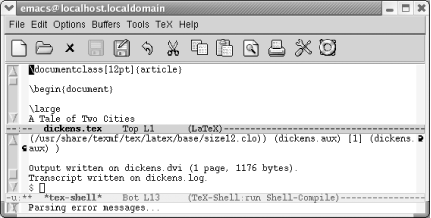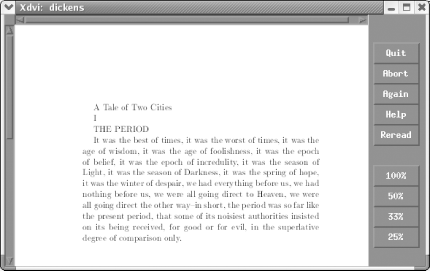8.5. Marking up Text for TEX and LATEX
| GNU Emacs provides excellent support for marking up TEX files. Most people today use LATEX , which is written in TEX and provides more control over formatting. As a result, we'll talk about LaTeX mode here. Before we launch into this discussion, we assume that you have set up LATEX on your platform. On Red Hat Linux, it's set up by default. Windows and Mac OS X users must install and configure LATEX before proceeding.[12]
Emacs attempts to guess whether you're editing a TEX or LATEX file and enter the appropriate mode. You can force LaTeX mode if Emacs doesn't enter it automatically by typing M-x latex-mode Enter. 8.5.1 Matching BracesLATEX commands often take the form \keyword{text}. LaTeX mode doesn't try to figure out if you're using the "right" keywords since the language is extensible and you may have defined your own keywords. It does, however, provide support for avoiding the most common error: mismatched curly braces and dollar signs. In LATEX , curly braces ({}) and dollar signs ($$) should always appear in pairs; Emacs checks to make sure that each opening brace or dollar sign has a counterpart. When you type a closing brace or dollar sign, the cursor moves quickly to its counterpart (provided that it is on the screen; it shows the context in the minibuffer if it is not), then back again. Emacs generates braces in matching pairs. The command C-c { inserts opening and closing braces and positions the cursor for typing between the braces. Typing C-c } moves you past the right brace. It always finds the correct closing brace, given your current position. If there is no closing brace, you get an error message that says Scan error: Unbalanced parentheses. You also get this error message if you type C-c } while the cursor is in a section that is not surrounded by braces, which can be a little confusing. To check for mismatched curly braces and dollar signs, type M-x tex-validate-buffer Enter. This command checks the entire buffer for unbalanced parentheses, curly braces, dollar signs, and the like. (If you have a large file, you might want to validate a region instead using M-x tex-validate-region Enter). If it finds any errors, Emacs displays an *Occur* buffer with Mismatches: at the top and a list of lines on which it found errors. You can then easily move to each line that contains an error with M-x goto-line. Sometimes a mismatched parenthesis early in the buffer can start a chain reaction of "errors" through the rest of the file. If you suspect that one of the corrections you make may have fixed most of the remaining errors, simply run tex-validate-buffer again. When you're stepping through errors, C-c } provides a good way to check where the closing brace for a given opening brace is. Position the cursor right after the opening brace and press C-c }. 8.5.2 Quotation Marks and ParagraphingLaTeX mode also has features for handling quotation marks and paragraph separation. Typing a quotation mark (") causes Emacs to simulate left and right quotation marks. Left quotation marks are represented as two backtick characters (``) while right quotation marks are represented as two apostrophes (' '). (Left and right quotation marks are not part of the standard ASCII character set.) If you need to type a literal quotation mark for any reason, simply use the quote-character command preceding the quotation mark, like this: C-q ". 8.5.3 Command PairsLaTeX mode provides support for inserting command pairs. To insert a command pair, type C-c C-o (for latex-insert-block). Emacs prompts for the block name, and then for associated options. For example, type C-c C-o Enter document Enter Enter (the second Enter indicates no options). Emacs inserts the command pair and positions the cursor between them: \begin{document} \end{document}You can use this command to mark up a text file after you write it. If you mark a region, you can type C-c C-o to wrap a command pair around that region. A related command is C-c C-e (for latex-close-block). In this case, you type an opening command, press C-c C-e, and Emacs inserts the corresponding closing command. These commands work with any keyword, regardless of what it is. Emacs can't check to make sure that it's a valid LATEX keyword or even that it's been defined. For example, if you type \begin{eating} C-c C-e, Emacs inserts \end{eating}. It's up to you to make sure you use valid keywords. 8.5.4 Processing and Printing TextIn addition to marking up files for LATEX , you can process files, see your errors (if any), and invoke a viewer, all without leaving Emacs. To process a file, just type C-c C-f (for tex-file).[13] Emacs saves the file before processing it. Messages that would appear on screen are channeled to a buffer called *tex-shell*, which Emacs displays on your screen. If the buffer isn't on the screen, typing C-c C-l (for tex-recenter-output-buffer) automatically displays it.
To demonstrate, let's try processing dickens.tex, a very basic file indeed.
This command generates a .dvi file, which is an intermediate, device-independent file. You can view the resulting file by typing C-c C-v. On Linux, the default viewer is xdvi. Pressing C-c C-v displays the output in an xdvi window.
To print the .dvi file, give the command C-c C-p (for tex-print); this formats the .dvi file and sends it to your default printer. C-c C-q (tex-show-print-queue) displays the print queue so you know when to go to the printer to look for your processed output. Two important variables tell Emacs how to print a TEX , file. You need to know about them if C-c C-p or C-c C-q doesn't work correctly; if these commands don't work, the configuration of TEX , on your system may be nonstandard, or the print and print queue commands are slightly different. The variable tex-dvi-print-command determines the command that is used to print a .dvi file; its default is lpr -d. For print queues, the command used to show the print queue is controlled by the tex-show-queue-command variable. By default, tex-show-queue-command is set to lpq. Table 8-9 summarizes TeX and LaTeX mode commands.
|
EAN: 2147483647
Pages: 161



